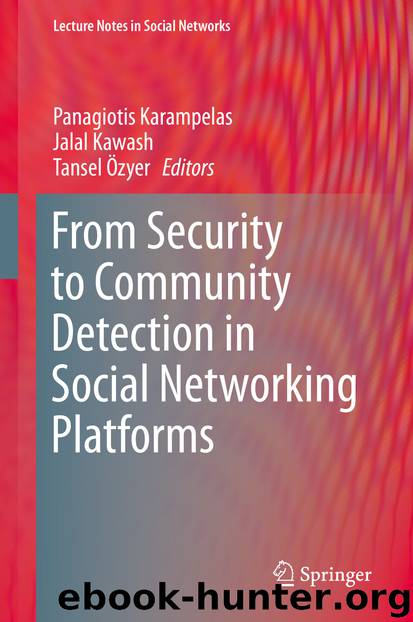From Security to Community Detection in Social Networking Platforms by Panagiotis Karampelas & Jalal Kawash & Tansel Özyer

Author:Panagiotis Karampelas & Jalal Kawash & Tansel Özyer
Language: eng
Format: epub
ISBN: 9783030112868
Publisher: Springer International Publishing
Graph Embedding
There have been many approaches to learning low-dimensional representations for graphs [4, 24, 29]. Inspired by the recent advancement in language modeling and deep learning [20], a series of graph embedding work that learn latent vertex representations of graphs have been proposed. DeepWalk [23] takes advantage of local structure information of vertices based on the Skip-Gram model [20] to learn the latent representations by treating random walks as the equivalent of sentences. When applied for multilabel graph classification in social networks, DeepWalk can successfully encode the global graph structure especially in the presence of missing information in graphs. Line [28] is a scalable graph embedding method that uses edge sampling for model inference. It naturally breaks the limitation of the classical stochastic gradient decent method adopted in graph embedding without compromising embedding efficiency. GraRep [8] refines DeepWalk by introducing an explicit loss function of the Skip-Gram model defined on the graph and extends Line by capturing k-step (k > 2) high-order information for learning the latent representations. Matrix factorization algorithms are used for optimization in GraRep.
Our work differs from existing graph embedding solutions in the following two aspects: (1) graph embedding is typically proposed and optimized for the task of graph classification, while our work is primarily designed for attributed graph clustering; (2) graph embedding considers encoding the mere graph structure into a low-dimensional space, while our work is the first to take into account attributed graphs and thus enriches the existing frameworks for attribute-aware graph embedding.
This work is an extended version of our previous conference paper [1]. We provide details of our attributed graph embedding algorithm with theoretical justifications. We also include thorough experimental results with other large-scale real-world attributed graphs and a set of synthetic attributed graph by varying several parameters including number of vertex and vertex dimensionality. We compare AA-Cluster with other state-of-the art methods. We examine the effects of our algorithm’s parameter such as neighborhood distance, length and number of random walks per vertex, and window size. Moreover, we analyze the scalability of our methods and compare with others. We find that our attributed graph clustering method has excellent scalability, while others cannot scale in large graphs with giving memory error after some points.
Download
This site does not store any files on its server. We only index and link to content provided by other sites. Please contact the content providers to delete copyright contents if any and email us, we'll remove relevant links or contents immediately.
| Access | Data Mining |
| Data Modeling & Design | Data Processing |
| Data Warehousing | MySQL |
| Oracle | Other Databases |
| Relational Databases | SQL |
Algorithms of the Intelligent Web by Haralambos Marmanis;Dmitry Babenko(16235)
Azure Data and AI Architect Handbook by Olivier Mertens & Breght Van Baelen(7674)
Building Statistical Models in Python by Huy Hoang Nguyen & Paul N Adams & Stuart J Miller(7657)
Serverless Machine Learning with Amazon Redshift ML by Debu Panda & Phil Bates & Bhanu Pittampally & Sumeet Joshi(7529)
Driving Data Quality with Data Contracts by Andrew Jones(7293)
Data Wrangling on AWS by Navnit Shukla | Sankar M | Sam Palani(7290)
Machine Learning Model Serving Patterns and Best Practices by Md Johirul Islam(7031)
Learning SQL by Alan Beaulieu(6237)
Weapons of Math Destruction by Cathy O'Neil(6216)
Big Data Analysis with Python by Ivan Marin(5934)
Data Engineering with dbt by Roberto Zagni(4931)
Solidity Programming Essentials by Ritesh Modi(4565)
Time Series Analysis with Python Cookbook by Tarek A. Atwan(4399)
Pandas Cookbook by Theodore Petrou(4087)
Blockchain Basics by Daniel Drescher(3540)
Natural Language Processing with Java Cookbook by Richard M. Reese(3143)
Hands-On Machine Learning for Algorithmic Trading by Stefan Jansen(3045)
Learn T-SQL Querying by Pam Lahoud & Pedro Lopes(2930)
Feature Store for Machine Learning by Jayanth Kumar M J(2926)
